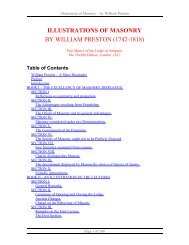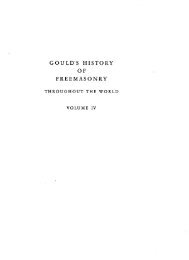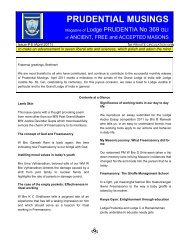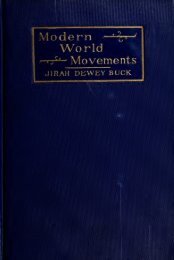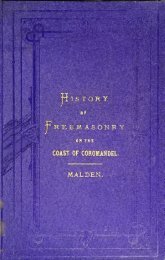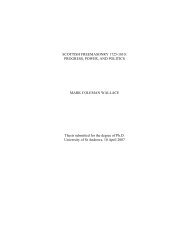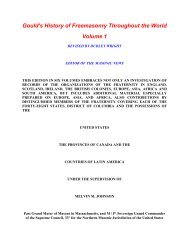The Origin of Freemasonry and Knights Templar ... - Lodge Prudentia
The Origin of Freemasonry and Knights Templar ... - Lodge Prudentia
The Origin of Freemasonry and Knights Templar ... - Lodge Prudentia
You also want an ePaper? Increase the reach of your titles
YUMPU automatically turns print PDFs into web optimized ePapers that Google loves.
SUPPLEMENTAL EXCYCLOP/ED1 AHigh. In the highest <strong>and</strong> central part <strong>of</strong> the region, seventhous<strong>and</strong> feet above the- level <strong>of</strong> the sea, rises tin- sacredsummit <strong>of</strong> llorel, or Sinai. <strong>The</strong> two names are used almostindiscriminately in the T>ible. iScripttire passages rathershow that Horeb was the general name for the group, <strong>and</strong>Sinai the name <strong>of</strong> the sacred summit.Symbol A symbol is defined to be a visible sign withwhich a spiritual feeling, emotion or idea is connected.It was in this sense that the early Christians gave the name<strong>of</strong> symbols to all rites, ceremonies <strong>and</strong> outward forms whichhave a religious meaning; such, for instance, as the cross<strong>and</strong> other pictures <strong>and</strong> images, <strong>and</strong> even the sacraments <strong>and</strong>the sacramental elements. At a still earlier period the Egyptianscommunicated ,the knowledge <strong>of</strong> their esoteric philosophyin mystic symbols. "<strong>The</strong> first learning <strong>of</strong> theworld," says Stukely, "consisted chiefly <strong>of</strong> symbols. <strong>The</strong>wisdom <strong>of</strong> the Chaldeans, Phoenicians, Egyptians. Jews, <strong>of</strong>all the ancients that is come to our h<strong>and</strong>, issymbolic.""Symbolical representations <strong>of</strong> things sacred," says Dr.Barlow, "were coeval with religion itself as a system <strong>of</strong>doctrine appealing to sense, <strong>and</strong> have accompanied itstransmission to ourselves from the earliest known period<strong>of</strong> monumental history." Egyptian tombs <strong>and</strong> stiles exhibitreligious symbols still in use among Christians. Similarforms, with corresponding meanings, though under differentnames, are found among the -Indians, <strong>and</strong> are seen onthe monuments <strong>of</strong> the Assyrians, the Etruscans <strong>and</strong> theGreeks. <strong>The</strong> Hebrews borrowed much <strong>of</strong> their early religioussymbolism from the Egyptians, their later from theBabylonians, <strong>and</strong> through them this symbolic imagery, bothverbal <strong>and</strong> objective, has descended to ourselves.Syria In Hebrew, Aram, a large district <strong>of</strong> Asia,lying, in the widest acceptation <strong>of</strong> the name, between theMediterranean Sea on the west, the Taurus range on thenorth, the Tigris River on the east, <strong>and</strong> Arabia Deserta <strong>and</strong>199



